Payments System Board Annual Report – 2020 Trends in Payments, Clearing and Settlement Systems
The Payments System Board monitors trends in retail payments, and activity and risk exposures across financial market infrastructures (high-value payment systems, securities settlement systems and central counterparties). This helps the Board fulfil its responsibilities to promote efficiency and competition, and control risk, in the Australian payments system.
Retail Payments
Australians are preferring to make payments electronically
Over recent decades, there has been a trend rise in the use of electronic payment methods for retail transactions and a decline in ‘paper based’ methods such as cash and cheques (Graph 1). In 2019/20, Australians made around 560 electronic transactions on average, compared with 250 a decade earlier. By contrast, the use of cash and cheques has fallen significantly. It is estimated that Australians made about 170 cash transactions per person on average in 2019, compared with 320 per person in 2007, and cheques are now seldom used for consumer payments. The shift to electronic payments reflects both consumer preferences for, as well as greater acceptance of, electronic payments for a range of transactions. Innovation and the introduction of new digital payment services, including by some technology-focused firms, has widened the range of electronic payment options available for Australian consumers and businesses.

Payment cards are the most frequently used payment method in Australia. In 2019/20, Australian cardholders made around 10.7 billion debit and credit card purchases worth $677 billion, with cards accounting for three-quarters of the total number of non-cash retail payments (Table 2). According to the Bank's 2019 Consumer Payments Survey (CPS), debit cards have now overtaken cash as the most commonly used payment method by Australian consumers (see ‘Box A: 2019 Consumer Payment Survey’).
When measured in terms of the value rather than the number of payments, Direct Entry payments, which include direct credits and direct debits, account for the bulk of non-cash retail payments. However, since the introduction of the New Payments Platform (NPP) in 2018, banks have started to migrate some direct credits (such as ‘pay anyone’ transactions) to the NPP (which currently can only be used for credit or ‘push’ payments). This likely contributed to the 2.2 per cent fall in the number of Direct Entry payments in 2019/20, compared with average annual growth of 5.8 per cent over the past decade. By contrast, the number of NPP transactions more than doubled in 2019/20, although it still accounted for only 2.9 per cent of the number of non-cash payments. The number of BPAY transactions, which are used for bill payments, increased by 0.4 per cent in 2019/20, which was notably lower than the average annual growth rate over the past decade.
| 2019/20 | Average annual growth 2009/10 to 2019/20 |
|||||||||
|---|---|---|---|---|---|---|---|---|---|---|
| Per cent of total | Average value | Growth, per cent | Per cent | |||||||
| Number | Value | $ | Number | Value | Number | Value | ||||
| Card purchases(a) | 74.8 | 5.0 | 63 | 7.6 | 3.3 | 11.4 | 6.8 | |||
| Debit cards | 54.3 | 2.6 | 46 | 10.4 | 9.8 | 13.9 | 10.8 | |||
| Credit cards | 20.5 | 2.3 | 109 | 0.7 | −3.1 | 6.7 | 3.7 | |||
| Direct Entry(b) | 19.2 | 80.3 | 3,984 | −2.2 | 5.9 | 5.8 | 3.8 | |||
| Direct credits | 12.8 | 55.3 | 4,101 | −3.5 | 5.5 | 4.6 | 4.4 | |||
| Direct debits | 6.3 | 25.0 | 3,748 | 0.4 | 6.9 | 9.0 | 2.6 | |||
| BPAY | 2.9 | 3.4 | 1,139 | 0.4 | 2.8 | 3.9 | 9.2 | |||
| Cheques | 0.3 | 3.4 | 9,816 | −21.0 | −28.6 | −17.1 | −11.0 | |||
| PEXA | 0.0 | 4.8 | 358,178 | 29.7 | 54.0 | – | – | |||
| New Payments Platform(c) | 2.9 | 3.0 | 1,005 | 167.3 | 214.9 | – | – | |||
| Total | 100.0 | 100.0 | 951 | 7.0 | 7.7 | 9.5 | 3.6 | |||
Sources: BPAY; RBA |
||||||||||
The high average value of BPAY payments means that they make up a larger share of the value of non-cash payments than either credit or debit cards, despite being less frequently used by consumers.
COVID-19 has reinforced these trends
The COVID-19 pandemic has accelerated the shift to electronic payments as consumers and merchants have sought to reduce their use of cash, in some cases due to health concerns about handling banknotes and coins. Many merchants encouraged the use of contactless card and mobile payments for in-store purchases, and consumers also changed their payment behaviour to avoid cash and contact with payment terminals. The payments industry supported the shift to contactless payments by temporarily increasing the no-PIN limit on contactless card transactions from $100 to $200 to further reduce the need to touch payment terminals. Banks have also promoted the use of mobile payments, which use biometrics on the device for authentication, and thus do not typically require the user to enter a PIN on payment terminals. Furthermore, banks have encouraged customers to set up debit card and online banking services if they did not already have them, and obtained dispensation from the Australian Securities and Investments Commission (ASIC) to proactively send debit cards to customers with a passbook account or transaction account without a linked debit card. The pandemic has also induced a significant shift to online shopping. Australian Bureau of Statistics (ABS) data show that the online share of retail spending picked up significantly from April and remains high by historical standards.
Cash use is declining but it is still important
The Bank's 2019 CPS showed a continuation of the long-term trend away from cash for many consumer transactions (see ‘Box A: 2019 Consumer Payment Survey’). Cash accounted for 27 per cent of the number of consumer payments in 2019, compared with 69 per cent in 2007 (Graph 2, left panel). When measured by the value of payments (rather than the number), 11 per cent of consumer payments were made in cash in 2019, compared with 18 per cent in 2016 and 38 per cent in 2007 (Graph 2, right panel). The recent decline in the share of cash payments was particularly pronounced for lower-value purchases made in person, where consumers are increasingly using cards (or sometimes mobile devices) to make contactless (‘tap and go’) payments.
Although the use of cash for transactions has continued to fall, a significant minority of people still heavily rely on cash for many of their payments. For example, older Australians and those on lower incomes tended to use cash relatively frequently, although for a smaller share of transactions than they did in the past. As the transition away from cash to electronic payment methods continues, it will be important to consider the needs of those members of society who continue to rely on cash for their day-to-day payments.

Consistent with the long-term decline in transactional use of cash, Australians are making fewer ATM cash withdrawals than they did a decade ago (Graph 3, left panel). The reduction in cash withdrawals was particularly pronounced in 2019/20, reflecting the impact of the COVID-19 pandemic. The number and value of ATM withdrawals fell by 19 per cent and 12 per cent in 2019/20 respectively, with most of the decline concentrated in the months of March and April.
Box A
2019 Consumer Payment Survey
The Bank undertook its fifth triennial Consumer Payments Survey (CPS) in October and November 2019.[1] A little over 1,100 respondents completed the survey, which consisted of three parts: a pre-diary questionnaire about the demographic characteristics of respondents; a seven-day payments diary; and a post-survey questionnaire about respondents' automatic payment arrangements and their preferences and attitudes about different payment methods. The CPS was conducted prior to the emergence of COVID-19 in Australia and provides a detailed snapshot of consumer payment patterns prior to the pandemic.
The CPS confirmed that Australian consumers had continued to switch to electronic payment methods from cash for many payments. Debit cards were the most frequently used payment method overall, accounting for 44 per cent of the number of payments over the diary week, compared with 30 per cent in the 2016 survey (Graph A1). Growth in card use was largely because cards were used more frequently for in-person payments, with an increase in particular in the use of contactless ‘tap and go’ functionality. Around half of all in-person payments in the 2019 survey were made by tapping a physical (plastic) card on a terminal, with a further 5 per cent made by tapping a smartphone or other payments-enabled device.
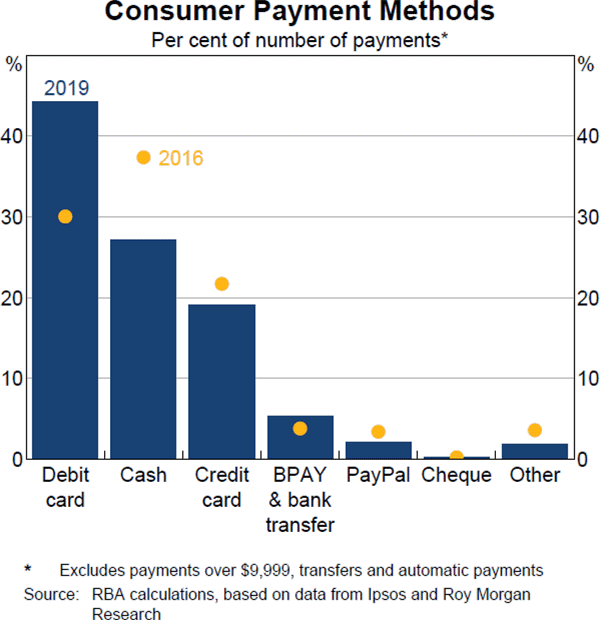
As more payments were made electronically, the use of cash declined further – 27 per cent of the number of payments were made with cash in 2019, compared with 37 per cent in 2016. In recent years, the decline in the use of cash has been particulary pronounced for lower-value transactions at the point of sale, consistent with growth in the use of cards with contactless functionality. The CPS also showed that the share of people who rarely use cash is rising – for example, one-third of survey participants did not record any cash payments during the week of the survey, compared with less than one-fifth in 2016. However, some people continued to use cash intensively. Participants aged over 65, for example, used cash for around half of their weekly payments on average and lower-income consumers also tended to pay in cash fairly frequently. Across all age groups, around 10 per cent of respondents made all of their payments in cash during the diary week, which was little changed compared with three years earlier.
Similar trends in cash and card use have been apparent in a number of other economies. Data from broadly similar surveys conducted by a number of other advanced economies show that consumers globally are shifting away from cash to cards, although there are also some notable differences across countries (Graph A2). Sweden and Norway are prominent examples of jurisdictions where cash is now used for a relatively small proportion of consumer payments, whereas cash is still commonly used in some euro area countries.
The growth in electronic payments has been associated with a trend towards payments becoming more ‘seamless’ from the perspective of consumers. An example of this has been increasing use of automatic payment arrangements such as direct debits for household bills. In the 2019 CPS, 81 per cent of respondents had at least one automatic payment arrangement, compared with 65 per cent in 2016. Another example is that a significant proportion (45 per cent) of respondents had used debit and/or credit card details that they had stored on a mobile device or online to make a payment in the previous year.
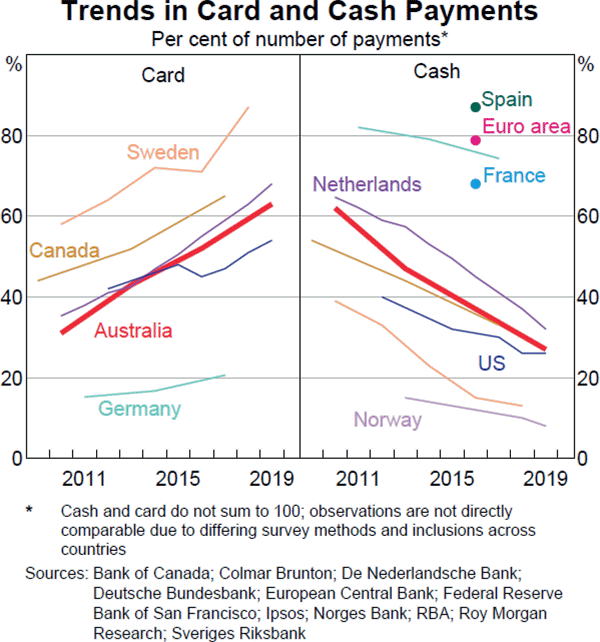
Footnote
For a summary of findings from the 2019 CPS, see Caddy J, L Delaney, C Fisher and C Noone (2020), ‘Cash Use in Australia: Results from the 2019 Consumer Payments Survey’. Available at <https://www.rba.gov.au/publications/bulletin/2020/mar/consumer-payment-behaviour-in-australia.html>. [1]
The ongoing reduction in the use of ATMs, along with the fact that many bank ATMs no longer charge fees, has prompted ATM deployers to rationalise their fleets over the past few years. The total number of active ATMs in Australia declined by 15 per cent (around 5,000 machines) since the peak in 2016 to around 28,000 ATMs in March 2020 and has since fallen further primarily due to the temporary closure of venues under COVID-19 restrictions (Graph 3, right panel). The changes in payment patterns induced by COVID-19 are likely to place further pressure on ATM deployers to rationalise their fleets. Two major banks recently sold most of their off-branch ATM fleets to cash logistics operators, and other banks may be considering similar arrangements, which could lead to the creation of one or more ATM utilities. So far, the largest declines in ATM numbers appear to have been in locations such as metropolitan shopping areas where there are other ATMs nearby, and Australians generally appear to have good access to cash services. For example, around 90 per cent of 2019 CPS respondents indicated that access to cash withdrawal services was ‘convenient’ or ‘very convenient’. This is consistent with previous Bank research that found that cash access – as measured by the average distance to the nearest ATM, bank branch or Bank@Post post office – was still good despite the decline in the number of cash access points over recent years (see ‘Box A: Access to Cash Services’ in the 2018/19 Payments System Board Annual Report).

Notwithstanding the ongoing decline in the use of cash for consumer transactions, overall demand for cash has continued to grow. At the end of June 2020, there were 1.8 billion banknotes in circulation, worth $90.1 billion. The value of banknotes in circulation increased by around 12.6 per cent over 2019/20, compared with annual growth of around 5 per cent in recent years. The above-average growth in circulation reflected increased demand for high denomination banknotes in the months following the outbreak of the COVID-19 pandemic as heightened uncertainty appeared to increase precautionary demand by the public. The role of cash as a precautionary store of wealth was also evident in the 2019 CPS, where 38 per cent of respondents reported that they held some cash outside of their wallet or purse, with funding for ‘emergency transactions’ the most commonly cited reason for doing so.
Cheques are now seldom used for retail payments
Cheque use in Australia has been declining at a rapid rate over the past decade, as consumers and businesses have been transitioning to electronic payment methods (Graph 4). In 2019/20 the number of cheque payments fell by 21 per cent compared to the previous year. There were less than 1.9 cheque transactions per person in the year (compared with around 45 per person in the mid 1990s) and cheques accounted for less than ½ per cent of all non-cash payments (by number). The decline in the value of cheques in 2019/20 was driven by a sharp fall in financial institution (bank) cheques, which are typically used for relatively large purchases such as property transactions; the COVID-19 pandemic is likely to have accelerated the shift from using cheques for property settlements to e-conveyancing platforms such as Property Exchange Australia (PEXA). South Australia has mandated the use of e-conveyancing from August 2020, bringing it in line with Victoria, NSW and Western Australia.

The CPS confirmed that personal cheques are rarely used for consumer payments, accounting for 0.2 per cent of the number of consumer payments in 2019 (compared with 1.2 per cent in 2007). Because cheques tend to be used for relatively large payments, they accounted for a slightly higher share – 2.1 per cent – when measured by the value of payments, and around 15 per cent of respondents reported that they had made at least one cheque payment sometime in the previous year. Cheques were mainly used by older Australians, with all of the cheque payments recorded in the week of the 2019 CPS made by respondents aged over 50.
Because cheques are now seldom used, the industry is considering how and when to wind up the cheque system given the high (and rising) per-transaction cost of supporting cheque payments. An important element of this transition is making sure suitable alternative payment methods are available and accessible for those who have continued to use cheques. In this regard, the COVID-19 pandemic and associated policy measures may have encouraged a transition away from cheques for some users. For example, financial institutions have assisted people in signing up to online banking and encouraged the use of debit cards by people who did not previously have one (e.g. passbook holders). In addition, anecdotal evidence points to the pandemic having induced changes in payments behaviour by some people who might previously have been reluctant to use electronic payment methods.
Cards are displacing cash for more transactions
Payment cards account for around three-quarters of all non-cash payments, with debit cards the most frequently used payment method in Australia (Table 2). In 2019/20, the number and value of card payments made by domestic cardholders grew by 7.6 per cent and 3.3 per cent, respectively. This compares with average annual growth of 11 per cent (number) and 6.8 per cent (value) over the preceding 10 years. Below-average growth in card payments in 2019/20 largely reflected a sharp fall in consumer spending in late March and in April because of the pandemic (Graph 5). The average value of card payments fell to $63 in 2019/20, down from just over $80 five years ago, with the 2019 CPS confirming that cards are increasingly displacing cash for many lower-value transactions (Graph 6).


In recent years, an increasing share of card payments have been made remotely (online or via mobile apps) rather than in person, consistent with the trend towards online shopping and the popularity of ride sharing and online delivery apps. As at June 2020, remote transactions accounted for around one-third of all card transactions, compared with 22 per cent five years earlier (Graph 7). The share of remote transactions increased in the early stages of the pandemic as consumers shifted to online shopping, before returning to previous levels as government virus containment restrictions were eased in some states.

Not surprisingly, the value of transactions using foreign-issued cards in Australia and international transactions using Australian-issued cards have both been severely affected by the COVID-19-related restrictions on overseas arrivals and international tourism. In the year to March 2020, around $1.8 billion transactions per month were made using foreign-issued cards in Australia, but only $1.0 billion per month in the three months to June 2020.
Debit cards are increasingly popular …
When paying with a card, Australians are increasingly choosing debit cards rather than credit cards. Over the past decade, the value of debit card payments has grown at an average annual rate of 11 per cent, compared with 3.7 per cent for credit cards (Graph 5). Moreover, the number of domestic credit card accounts has fallen by 12 per cent since 2018. The 2019 CPS showed that debit cards are now the most frequently used method of payment by Australian consumers, accounting for 44 per cent of surveyed transactions, compared with 19 per cent for credit cards. The increase in the popularity of debit cards compared with credit cards is likely to reflect a range of factors, including reductions in the generosity of credit card rewards programs and changing attitudes towards accumulating this type of personal debt, particularly among younger consumers. Indeed, CPS respondents aged under 30 made just under 70 per cent of their payments using debit cards in 2019, compared with an average of 44 per cent for all respondents (Graph 8). Another factor has been the introduction in the mid 2000s of international scheme debit cards, which provide much of the same payment functionality as credit cards (e.g. the ability to make contactless and online payments). More recently, it is possible that the emergence of new ways of funding consumer purchases – such as buy now, pay later (BNPL) services – may have also played a role in the continuing decline of credit cards by providing alternative ways to smooth spending and manage cash flows.

The debit and credit card markets in Australia are dominated by two international card schemes, Visa and Mastercard. In the debit card market, the share of transactions made using these two schemes has been increasing for much of the past decade, while the share of the domestic debit scheme, eftpos, has been declining. The decline in eftpos' market share can partly be attributed to the increasing use of contactless payments, given that the international schemes are the default networks on dual-network debit cards. In addition, the eftpos network only recently began supporting some online and other remote transactions, which have been making up an increasing share of card payments (particularly during the COVID-19 pandemic). However, the take-up of least-cost routing functionality by some merchants over the past year or so has slowed the decline of eftpos' market share (see the ‘Retail Payments Regulation and Policy Issues’ chapter).
For credit card payments, the combined market share of Mastercard and Visa has also increased over recent years, to around 84 per cent by value of transactions in 2019/20. The fall in the combined market share of American Express and Diners Club over this period largely reflects the closure of the major banks' American Express companion card programs. This followed regulatory reforms by the Reserve Bank in 2016 that made the American Express companion card system subject to equivalent regulation to that which applies to the Mastercard and Visa systems. However, part of the decline in market share from the closure of the companion card arrangements has been offset recently by increased issuance of American Express proprietary cards.
… and many card payments are now contactless
The way in which consumers use their cards at the point of sale has changed significantly over the past decade or so. Most in-person card payments are now made using contactless (‘tap and go’) functionality rather than by inserting the card into the terminal, and consumers are also increasingly storing their card details in digital wallets on their mobile devices and using those to make contactless payments (see below). In the 2019 CPS, 50 per cent of in-person payments were made using a physical card with contactless functionality, and a further 5 per cent used payment-enabled mobile devices (compared with a combined total of 35 per cent three years earlier) (Graph 9). The share of payments made using contactless functionality is likely to have further increased since the CPS was conducted as consumers and merchants have preferred contactless card payments to handling cash or interacting with payment terminals during the COVID-19 pandemic.
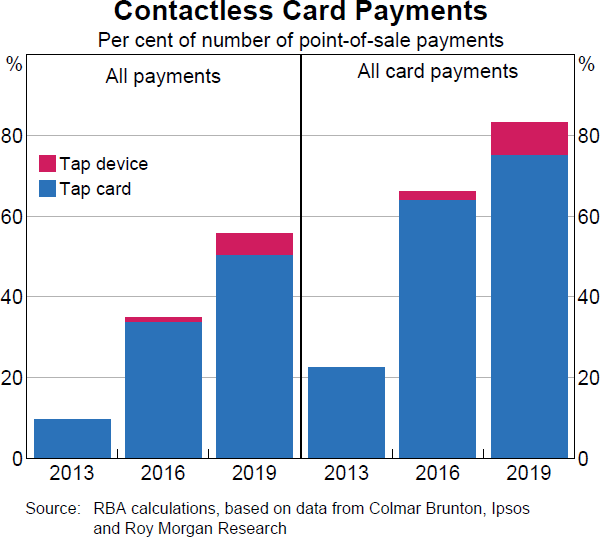
Innovation is changing the way retail payments are made
Australian consumers have access to a wider range of electronic alternatives to cash and traditional (plastic) cards than they did even a few years ago. A number of innovative new payment services have emerged or attracted increased attention in recent years, often facilitated by mobile device technology. Many of these services make use of existing card networks – e.g. by using stored card details ‘in the background’ – but enable consumers to use cards in new ways. An example of this is the use of linked debit or credit cards to fund instalment payments for purchases using BNPL services. Other innovations have involved the creation of new networks to facilitate payments, most notably the introduction of the NPP, which has provided consumers with the ability to make real-time, data-rich, account-to-account bank transfers using PayIDs.
Consumers are increasingly aware of new payment methods
The 2019 CPS indicated that consumers are increasingly aware of some these new methods of payment, though they do not necessarily use them often. BNPL services, paying by tapping a mobile device (like a smartphone or watch), digital wallets and ‘cryptocurrencies’ were among the most widely known alternative payment methods by participants in the 2019 CPS (Graph 10). In terms of use, around 20 to 35 per cent of people reported having made payments using BNPL services and mobile-enabled payment methods (in-app or ‘tap and go’) at least once in the previous year. Despite relatively high awareness, few consumers had used a ‘cryptocurrency’ such as Bitcoin to actually make a consumer payment in the previous 12 months; indeed less than one per cent reported having done so.
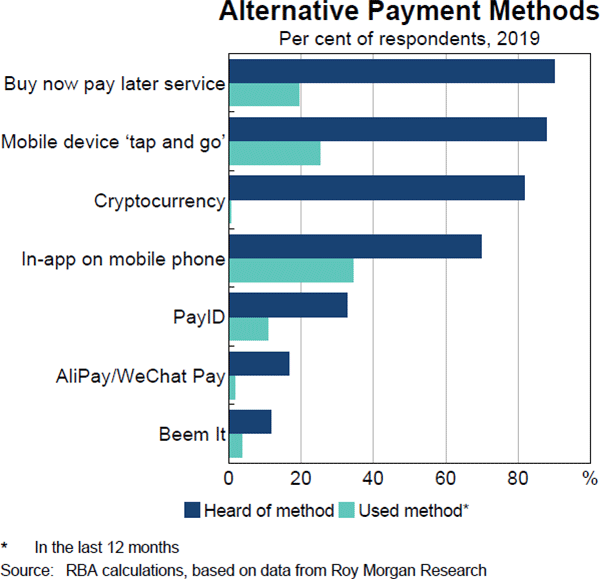
Digital wallets have been one of the most prominent innovations in consumer payments in recent years. These services enable consumers to store their debit and/or credit cards in a digital wallet application on their smartphone or other mobile device, which can then be used to make contactless payments at a card terminal, and in some cases for online payments. These services offer the convenience of not having to carry a physical card to make payments and they can use the biometric features built in to the mobile device to authenticate payments without having to enter a PIN. In the past few years, many card issuers have supported the use of their cards in digital wallet applications provided by Apple, Samsung and Google, for example. As noted, the use of contactless mobile payments has increased in recent years from a relatively low base, and the changes in payment behaviour associated with the COVID-19 pandemic may support a further increase in the period ahead.
New players are entering the market
A number of the new payments services introduced in recent years have been developed by large technology-focused firms, including ‘bigtechs’ like Google, Apple, Facebook and Amazon, which have been disrupting the payments industry. Along with digital wallets and payment functionality integrated into their own online platforms, in some jurisdictions these firms have started to offer a broader range of payment services, including peer-to-peer money transfer services and credit cards. In advanced economies, bigtech companies have generally offered payments services in partnership with local banks, using card schemes' existing network infrastructure to process payments. In Australia, bigtech firms' activities have so far focused on digital wallets and services that streamline the online checkout process for consumers (e.g. by using stored payment credentials for a more ‘seamless’ checkout). By contrast, in China and some other developing economies, technology platforms such as Alipay and WeChat Pay have fundamentally reshaped the payments market by creating their own payments infrastructure, and they now account for a very significant share of consumer transactions.
Another prominent development in the retail payments market in recent years has been the emergence of newer types of BNPL services. These services, often based on mobile apps, enable consumers to obtain goods and services from a participating merchant immediately and make subsequent payments to the BNPL provider in a series of low- or zero-interest instalments, typically over 1–2 months. The value of payments processed through BNPL services has grown rapidly, with transactions tripling over the past two years, to almost $10 billion in 2019/20 (Graph 11). Despite this strong growth, BNPL accounts for a relatively small share of overall payment flows, with payments initiated via BNPL equivalent to less than 1½ per cent of total card purchases over the year. BNPL has, however, gained significant traction in certain sectors like online goods retail, where market shares are likely to be higher.
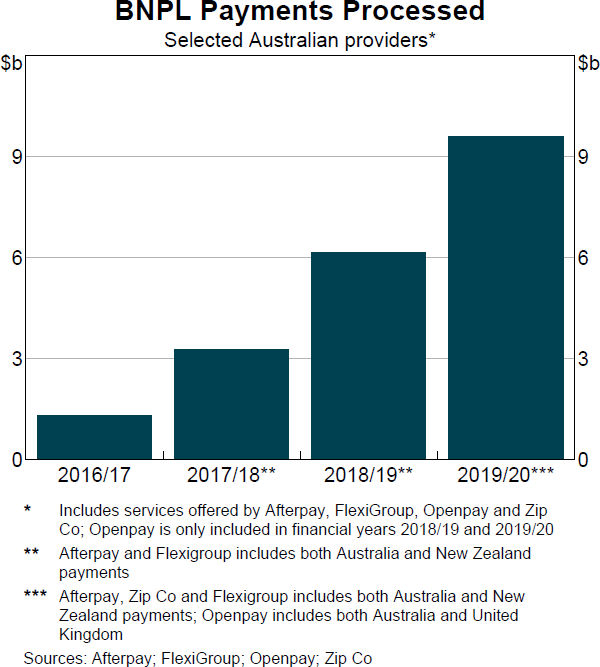
There has also been increased competition in this segment of the payments industry, with a number of new providers entering the market in the past year. For merchants, particularly early adopters, BNPL services may be attractive because they may facilitate increased sales. In addition, as merchants are paid upfront by the BNPL provider, they do not bear the risk of fraud or customer non-payment. However, merchants pay fees to the BNPL provider that are typically much higher than the fees they would pay on other payment methods, such as credit and debit cards. From a consumer perspective, the growing popularity of BNPL services may relate to their convenience and potential to provide a lower-cost alternative to consumer credit. Indications are that BNPL services are used more intensively by younger consumers – according to the 2019 CPS, 60 per cent of BNPL users were aged under 40 (Graph 12).
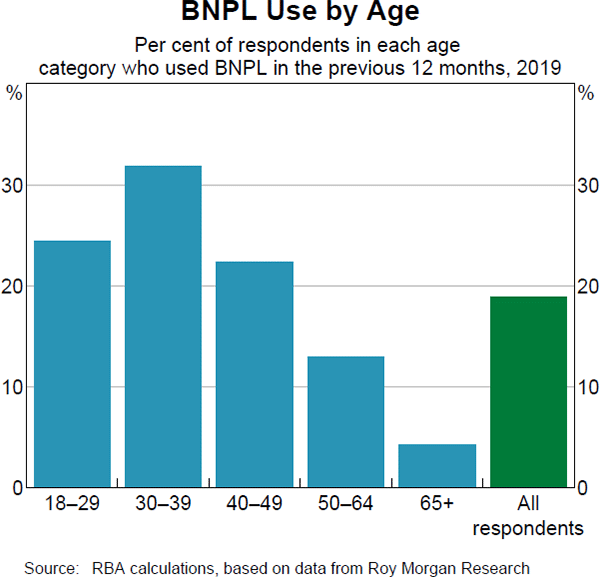
Cross-border retail payments is another area of the payments market that has been experiencing disruption from new technology-driven firms. New digital (online-only) providers of international money transfer services typically bypass traditional correspondent banking processes by collecting and dispersing funds across countries using local bank accounts, offering cheaper and faster money transfers than many banks.[7] Digital wallets that allow real-time transfers between currencies at the prevailing wholesale exchange rate are another service offered by some new entrants. The recent significant gains in market share by digital providers have been a factor spurring traditional providers to lower prices and improve the convenience and transparency of their offerings.
More payments are being made through the NPP
Making retail payments faster has been a strategic priority globally for a number of years. In Australia, the payments industry launched the NPP in 2018 to enable consumers, businesses and government agencies to make real-time, information-rich payments 24 hours a day, every day of the week. The NPP's PayID service provides the option for payments to be addressed to the account owner's registered mobile phone number, email address or Australian Business Number (ABN) rather than to a BSB and account number.
At the time of writing, there were 102 entities (including sub-brands and subsidiaries) offering NPP payment services to their customers. Thirteen of these are participants in the NPP, while the others, comprising smaller financial institutions and five non-bank providers, access the platform indirectly through the services of a sponsoring participant. The initial uptake of the NPP was somewhat slower than had been expected as some institutions took a phased approach to rolling out services to their customers according to their own priorities. However, there are now about 67 million Australian bank accounts accessible to send and receive payments via the NPP, with a further 4.5 million accounts able to receive incoming payments (together estimated at around 95 per cent of all accounts that will eventually be reachable). Over 5 million PayIDs have been registered.
NPP transactions picked up significantly over 2019/20 as financial institutions progressed the rollout of core functionality to end users. The Australian Government also started using the NPP for certain payments, including real-time funding of government agencies and some emergency welfare and disaster payments.
The average daily volume of NPP payments made in June was 2½ times that of the same month a year earlier, while the average daily value of transactions tripled over the same period. In aggregate, the platform processed around 412 million payments worth $414 billion in 2019/20 (Graph 13). The majority of these payments were made using Osko, an NPP overlay service provided by BPAY. Overall, the adoption of the NPP since its launch, measured in terms of the number of transactions per capita, compares favourably with the more successful fast payments systems that have been launched in other countries (Graph 14).
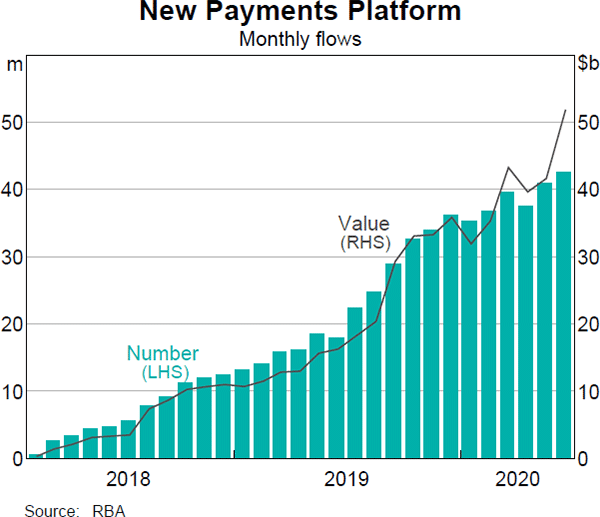
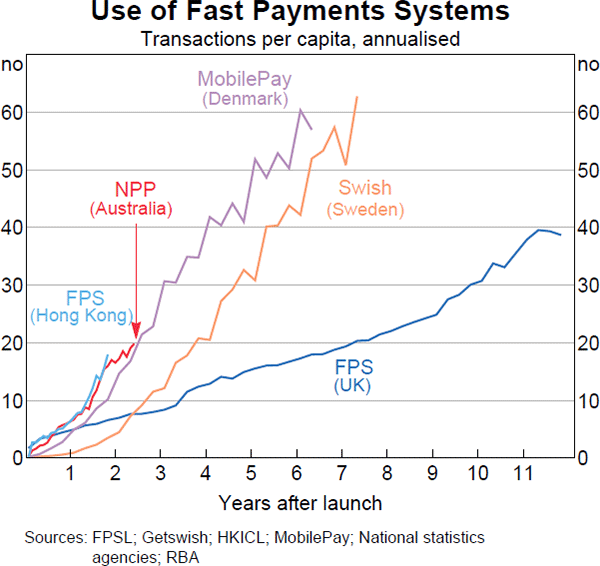
Retail payments data suggest that there has been some migration of payments to the NPP that would traditionally have been made through the Direct Entry system, such as ‘pay anyone’ transactions (via online banking) and certain government payments. There has also been some anecdotal evidence of merchants encouraging payments via the NPP as a substitute for cash during the COVID-19 outbreak. It is anticipated that there will be further growth in NPP transactions as additional financial institutions connect to the platform and make services available to their customers and as there is a further migration of transactions from the Direct Entry system. In addition, NPP Australia Limited (NPPA) and NPP participants are working on a roadmap to extend the capabilities of the NPP, including to enable recurring and debit-like payments through the NPP and new message data standards to support straight-through processing of specific types of payments (such as payroll, superannuation and tax payments) (see the ‘Retail Payments Regulation and Policy Issues’ chapter for more detail). These capabilities could be used by a range of entities to develop new, innovative and flexible payment solutions targeted to specific customer needs.
Changing payment patterns underscore the importance of electronic payments being inexpensive, reliable and safe
Some merchant fees have continued to decline …
Merchant fees are paid by merchants to their financial institutions (or directly to the card scheme in the case of American Express and Diners Club) for the provision of card acquiring services. The level of merchant fees is heavily influenced by the wholesale interchange fees paid from a merchant's financial institution (known as the acquirer) to the cardholder's financial institution (the issuer) for each transaction, as well as the scheme fees that acquirers pay to the card schemes. Merchant fees can also include annual or monthly fees, terminal rental fees and joining fees charged by acquirers.
Average merchant fees for international scheme cards have declined since the early 2000s when the Bank started its card payments reforms (Graph 15). In 2019/20, the average merchant fee for transactions on Mastercard and Visa debit cards fell by 6 basis points, to 0.46 per cent, continuing a downward trend seen over recent years. The latest decline was consistent with small reductions in the schemes' weighted-average interchange fees on debit transactions, as they responded to competitive pressures created by the availability of least-cost routing (LCR). The average merchant fee for eftpos transactions remained at 0.27 per cent throughout the year. Merchant-level data for 2018/19 show that transactions processed through eftpos were, on average, materially cheaper than the international debit schemes for most merchants (see Box B).
The average merchant fee for transactions on Mastercard and Visa credit cards declined by 2 basis points in 2019/20, to 0.89 per cent. The average fee for American Express also fell, to 1.36 per cent. These falls were concentrated in the June quarter, associated with a sharp decline in credit card spending during the pandemic. By contrast, the average merchant fee for Diners Club increased over the same period, although this scheme accounts for a very small share of transactions.
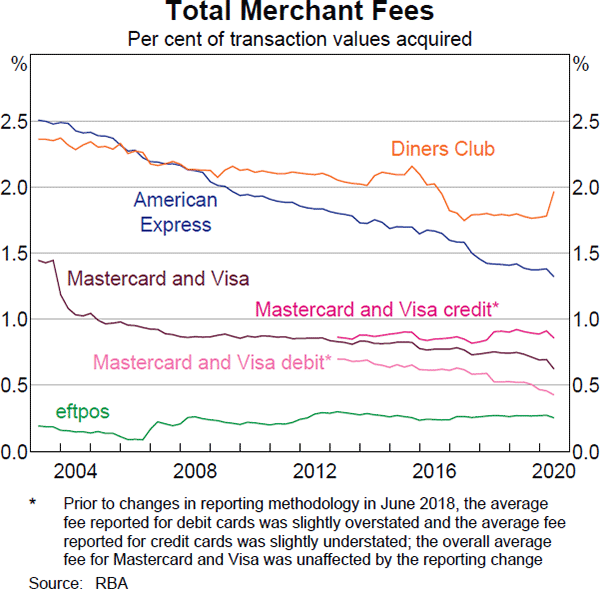
Box B
The Cost of Card Payments for Merchants[1]
The Bank collects various data on merchant payment costs in order to monitor trends in the cost of electronic payments to merchants. In late 2019, the Bank asked eight large acquirers for anonymised merchant-level data on the costs to their merchants of accepting different types of cards. Data were collected for about 672,000 merchant accounts, and included the total value of card payments processed through each of the four-party card schemes (eftpos, Debit Mastercard, Visa Debit, Mastercard credit, Visa credit and UnionPay) in 2018/19 and the corresponding value of merchant fees charged by the acquirer. The data matched the information that acquirers are required to provide in statements to their merchants each year under the surcharging framework of the Bank and the Australian Competition and Consumer Commission (ACCC).
Graph B1 shows how the cost of accepting card payments in 2018/19 (averaged across all of the four-party schemes) varied based on the size of the merchant. It is apparent from the darker areas in the heat map that merchants with a higher value of card transactions tended to pay less for accepting card payments than smaller ones. The tendency for merchants' average payment costs to fall as their transaction values rise was evident for each of the four-party schemes (Graph B2).
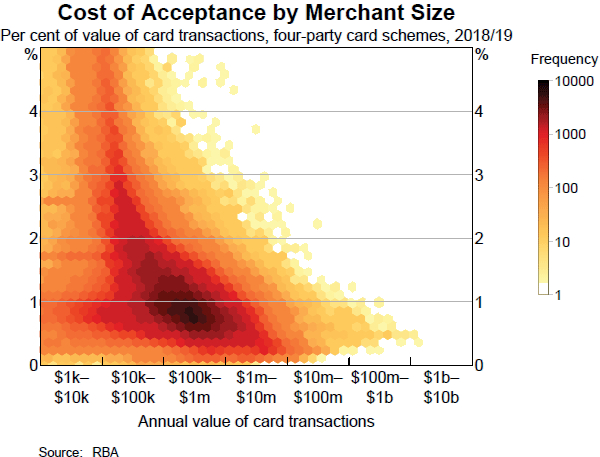
There are several possible reasons why smaller businesses tend to have higher average payment costs:
- Smaller businesses have a lower volume of transactions over which to spread the fixed costs associated with providing payment services to merchants (such as the provision of terminals).
- Larger merchants are more likely to benefit from favourable interchange rates from card schemes.
- There may be some impediments to competition in the acquiring market for smaller merchants. For example, smaller merchants are likely to have lower negotiating power with their acquirers, may face relatively high costs of switching to another acquirer, and may be less likely to choose, or be offered, plans that would minimise their payment costs.
The merchant-level data also showed that merchants of all sizes paid less on average for transactions processed via eftpos compared with the international debit schemes (Graph B2). Holding merchant size constant, the cost of acceptance for eftpos was on average around 37 basis points lower than international scheme debit, which in turn was around 36 basis points less than scheme credit. UnionPay costs were significantly higher than those of all the other four-party schemes, which would partly reflect the higher interchange fees charged on overseas-issued cards, though UnionPay transactions were a very small share of total transactions.
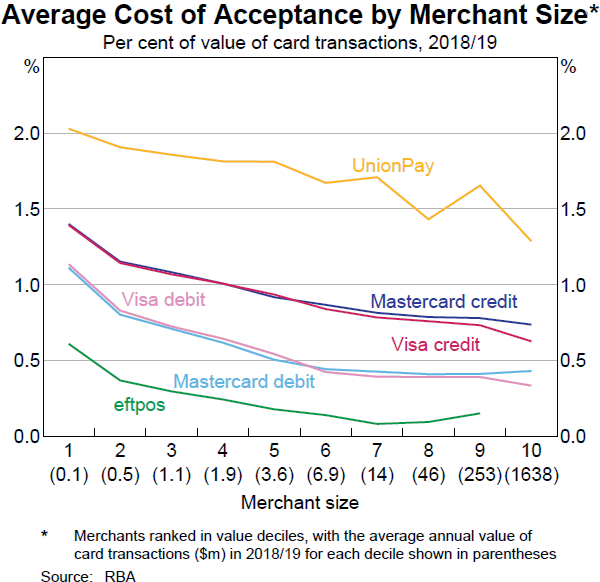
The differences in the costs of accepting transactions from different card schemes can reflect a range of factors. Two significant components of merchant fees are interchange fees (paid by the acquirer to the card issuer) and scheme fees (paid by the acquirer to the card scheme) – both of these fees are determined by the card schemes. In general, credit cards have higher interchange fees than debit cards, and interchange fees for eftpos transactions are lower on average than those for Visa and Mastercard debit. Another key component of merchant fees is the acquirer's margin, which may reflect factors such as the merchant's size, the services being provided and the type of pricing plan the merchant is on.
Some of the differences in the average merchant fees across schemes could also be explained by compositional differences in transaction types. For example, the merchant fee data for Visa and Mastercard debit cards, unlike those for eftpos, include fees for transactions on foreign-issued debit cards, which have significantly higher interchange fees than domestic transactions. In addition, during 2018/19, eftpos was only supported for card-present transactions (i.e. in-person payments). In contrast, Visa and Mastercard debit cards could also be used for card-not-present transactions (such as online purchases), which may have different interchange and/or scheme fees compared with card-present transactions.
The data also show that there were some merchants for which eftpos was not the lowest-cost debit scheme on average. Visa and Mastercard pricing is usually percentage-based, while eftpos is typically priced on a cents-per-transaction basis. This means that businesses with low average transaction values (such as coffee shops) may see little difference in the costs of accepting the different debit schemes and, in some circumstances, may face higher costs for eftpos. The merchant-level data for 2018/19 suggested that Visa and Mastercard debit were materially less expensive for around 9 per cent of the merchants (accounting for about 5 per cent of the value of card transactions). There was little difference between the costs of the debit networks for a further 15 per cent of the merchants.
Footnote
For more information, see Occhuitto (2020), ‘The Cost of Card Payments for Merchants’, RBA Bulletin, March, viewed 10 September 2020. Available at <https://www.rba.gov.au/publications/bulletin/2020/mar/the-cost-of-card-payments-for-merchants.html>. [1]
… outages in retail payments have continued to rise
The Bank collects data from banks and other financial institutions to monitor trends in the reliability of retail payments. These data show a substantial rise in the number and total duration of operational outages to retail payment services in recent years (Graph 16). Accordingly, since late 2019 the Bank has been working with the industry on measures to promote improved reliability in retail payment services (see the ‘Retail Payments Regulation and Policy Issues’ chapter). In 2019/20, there was a further rise in the aggregate duration of outages, reflecting a marked increase in the number of incidents and a slight lengthening in their average duration (i.e. the average time taken to restore services). By retail channel, online or mobile banking services continued to account for around half of the number of retail outages, while disruptions to card and NPP payment services were each about 10 per cent of the total. Software failures remained the leading reported cause of outages during the year. Institutions also experienced more problems relating to their telecommunications infrastructure and payments services provided by third parties, which illustrates some of the interdependencies that can impact the reliability of retail payment services.
The operational resilience of retail payments providers has been tested by the COVID-19 pandemic. Payment service providers had to adjust to new working arrangements, with key operational staff split across multiple sites or working from home. Another challenge has been heightened malicious cyber activity targeting financial institutions. Overall, retail payment providers have coped well since the COVID-19 outbreak began: there have been few very severe outages to electronic payment services and systems have remained secure. This has been a positive outcome; given the reduced use of cash in the pandemic, major disruptions to electronic payments and a loss of access to funds could have caused significant difficulties for consumers and merchants and a broader loss of confidence in the payments system. To some extent, however, the good outcomes on retail payments reliability may be partly explained by organisations having temporarily halted some system changes and updates, which could generate a backlog of important work that will need to be completed at a later time.
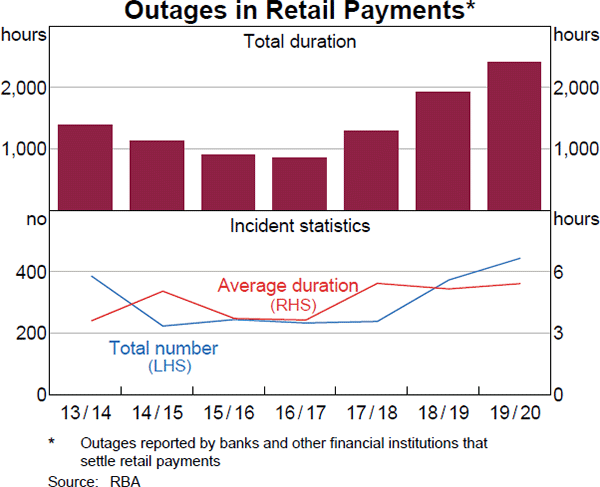
… while fraud on payment cards has declined of late
Payment security and prevention of fraud is also important for maintaining public confidence in electronic payment services. According to industry data collected by the Australian Payments Network (AusPayNet), total losses from fraudulent transactions on debit, credit and charge cards fell by 15 per cent in 2019, to $560 million (Graph 17). This was the first decline in total card fraud losses in eight years, and came despite strong growth in the use of cards over the year. The estimated fraud rate on card payments in 2019 was 67 cents per $1,000 spent, compared with a peak of 84 cents in 2017. Within this, the fraud loss rate on ‘domestic transactions’ (i.e. transactions on Australian-issued cards at Australian merchants) is considerably below that on either ‘outbound international transactions’ (i.e. Australian-issued cards used at overseas merchants) or ‘inbound international transactions’ (i.e. foreign-issued cards used at Australian merchants).
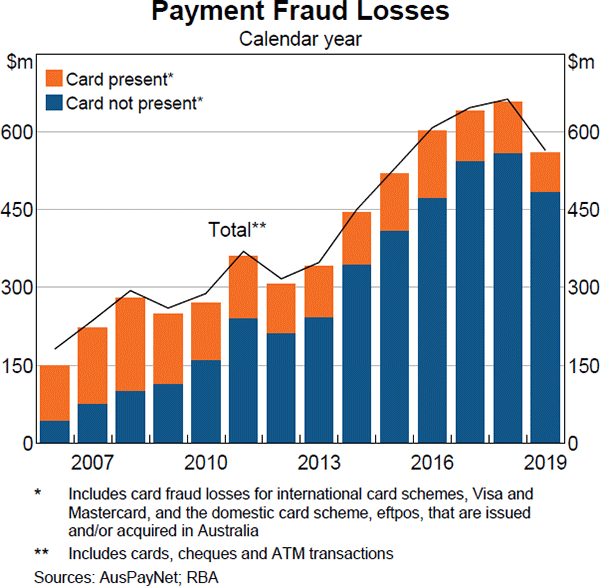
Total card fraud losses continued to be driven by the fraudulent use of international scheme cards for card-not-present (CNP) transactions (i.e. those undertaken by phone, mail order or online). There had been a marked increase in this type of fraud over recent years, driven by the rapid expansion in e-commerce and the increasing sophistication of online fraud methods. However, in 2019, CNP fraud losses declined by 13 per cent to $485 million, reflecting lower fraud losses on Australian-issued cards. This improved outcome is consistent with industry efforts to reduce CNP fraud through measures such as upgrading security where merchants hold card data, improved fraud detection tools and the tokenisation of card details. The CNP Fraud Mitigation Framework implemented by the industry in mid 2019 is also helping to reduce CNP fraud losses. A core element of this framework is a requirement for multi-factor authentication of the cardholder in online CNP transactions where either the merchant or issuer has consistently exceeded specified fraud thresholds (see the ‘Retail Payments Regulation and Policy Issues’ chapter). According to AusPayNet, of the merchants who have exceeded a fraud threshold in one of the first few quarters that the framework has been in place, two-thirds brought fraud levels below the threshold in the following quarter; the remainder are working closely with their acquirer to reduce their fraud loss rate.[8]
Card-present (CP) fraud losses also declined in 2019, to be $74 million or 13 per cent of total card fraud losses. CP fraud losses remain much lower than they were a decade ago, with the introduction of enhanced security measures, such as chip-and-PIN, which has helped reduce fraud losses from card skimming and counterfeiting.
Payments, Clearing and Settlement Systems
The high-value payments and settlements systems and central counterparties that operate in Australia process the bulk of activity that takes place in Australia's financial markets. Following the outbreak of COVID-19, financial markets in Australia – as in other economies – became extremely volatile in late February and through March. The increase in volatility was associated with heightened activity in financial markets in the first half of 2020, with peaks of daily activity in many segments of the financial markets well above previous levels seen. The key financial market infrastructures in Australia were generally able to process this heightened level of activity and did not experience service disruptions despite operating under business continuity arrangements (see ‘Box C: COVID-19 and Financial Market Infrastructures’ for more details).
High-value Payments and Settlements Systems
In Australia, the final settlement of Australian dollar (AUD) interbank payment obligations occurs across Exchange Settlement (ES) accounts through the Reserve Bank Information and Transfer System (RITS). RITS facilitates settlement of payments on a real-time gross settlement (RTGS) basis. Foreign exchange transactions involving the AUD are generally settled through CLS Bank International (CLS), with AUD funding paid to CLS through RITS. Together these two systems settle the majority of payments in Australia by value.
Reserve Bank Information and Transfer System
RITS is Australia's high-value payments system, which is used by banks and other approved institutions to settle their payment obligations on an RTGS basis. RITS also settles a wide range of payments:
- RITS is used to settle time-critical wholesale payments for other financial market infrastructures (FMIs): AUD pay-ins to or pay-outs from CLS; margin payments to central counterparties (CCPs); and debt and equity settlement obligations arising in securities settlement systems.
- RITS also facilitates the multilateral net settlement of interbank obligations arising from other systems. This includes the settlement of obligations from non-cash retail payments – such as cheques, Direct Entry payments and card transactions – most of which are netted among participating financial institutions and sent through the RITS Low Value Settlement Service for multilateral net settlement. RITS also settles Mastercard's AUD domestic obligations; eftpos scheme obligations; and property settlement transactions, managed by PEXA and ASX Financial Settlements Pty Limited (ASXFS). These payments are submitted to RITS as multilateral net batches sent through the RITS batch functionality, with property transactions only settling when the property transfer has been confirmed by the land titles office.
The daily average value of RTGS transactions settled in RITS in 2019/20 increased approximately 17 per cent over the previous financial year, with SWIFT transactions comprising the majority of payments settled by value (Graph 18; Table 3). In March 2020, a record $282 billion was settled on average per day, surpassing the previous peak month of June 2019 by around 20 per cent.
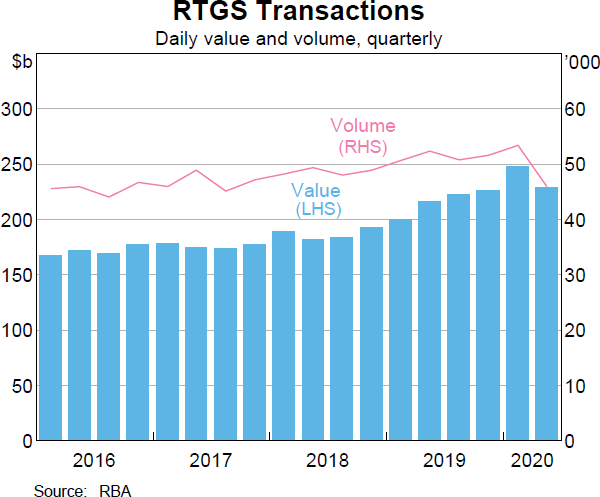
| Number(b) | Value(b) | Interbank settlement value in RITS | ||||||
|---|---|---|---|---|---|---|---|---|
| ′000s | Annual Growth (per cent) | $ billion | Annual Growth (per cent) | $ billion | Annual Growth(per cent) | |||
| RITS RTGS | 50 | – | 231 | 17 | 224 | 16 | ||
| SWIFT payments | 46 | – | 133 | 14 | 133 | 14 | ||
| Austraclear(c) | 4 | – | 85 | 25 | 76 | 24 | ||
| RITS cash transfers | – | – | 13 | 3 | 15 | 5 | ||
| CLS | 82 | 11 | 345 | 6 | 3 | 14 | ||
| Retail payments | 54,200 | 4 | 50 | 10 | 6 | 4 | ||
| Direct entry(d) | 12,500 | −1 | 46 | 13 | – | – | ||
| Cheques | 200 | −22 | 2 | −30 | – | – | ||
| Credit/charge cards | 11,500 | −1 | 1 | −5 | – | – | ||
| Debit cards | 30,000 | 9 | 1 | 8 | – | – | ||
| Equity settlements(e) | – | – | 12 | 17 | 1 | 18 | ||
| Property settlements(f) | – | – | 3 | 54 | 1 | 52 | ||
| NPP | 1,700 | 150 | 2 | 194 | 1(g) | 208 | ||
Sources: ASX; CLS; RBA |
||||||||
PEXA transactions have continued to grow strongly with a daily average value of approximately $3 billion, an increase of 54 per cent on last year (Table 3; Graph 19). Activity over the NPP has also continued to grow strongly, although daily average values in both NPP and PEXA remain small in comparison to daily average RITS RTGS values (Graph 19).
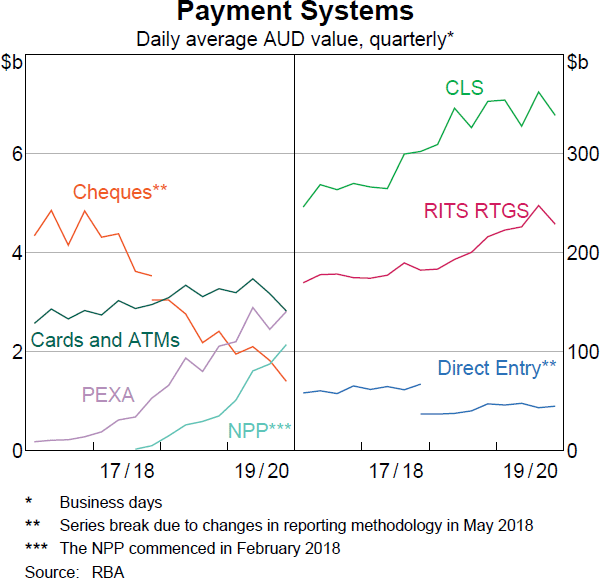
CLS Bank International
CLS is an international settlement system that links the settlement of the two legs of a foreign exchange transaction. By operating such a payment-versus-payment settlement mechanism, CLS allows participants to mitigate foreign exchange settlement risk, i.e. the risk that one counterparty to a transaction settles its obligation in one currency, but the other counterparty does not settle its obligation in the other currency. CLS currently settles 18 currencies. The daily average value of AUD settlements at CLS increased to around $345 billion in 2019/20 with peak activity recorded in March of $414 billion per day.
Securities settlement facilities
Securities settlement involves the delivery of the security in exchange for payment, typically through a securities settlement facility (SSF). In Australia, ASX Settlement provides SSF services for Australian Securities Exchange (ASX)-quoted cash equities, debt products and warrants traded on the ASX and Chi-X Australia Pty Ltd (Chi-X) markets. ASX Settlement also provides SSF services for non-ASX listed securities quoted on the National Stock Exchange of Australia and the Sydney Stock Exchange Limited. The average daily value of cash equity settlements through ASX Settlement increased by around 17 per cent in 2019/20 to $12.3 billion. Peaks in daily activity of above $35 billion occurred in March and June, well above the previous peak of $28.7 billion in March 2019 (Graph 20). The March peak in daily activity was driven by the settlement of a record volume of 7 million cash equities trades executed across all markets.
Austraclear Limited (Austraclear) provides SSF services for trades in debt securities, including government bonds and repurchase agreements. The average daily value of debt securities settled in Austraclear increased by around 25 per cent in 2019/20, to $69.5 billion. Peak settlement activity in 2019/20 exceeded that of the previous financial year on 15 occasions between March and June, with a maximum value of $113.2 billion being settled on 21 May (Graph 21). Most of the peak days were driven by settlement of new bonds issued by the Australian Government.
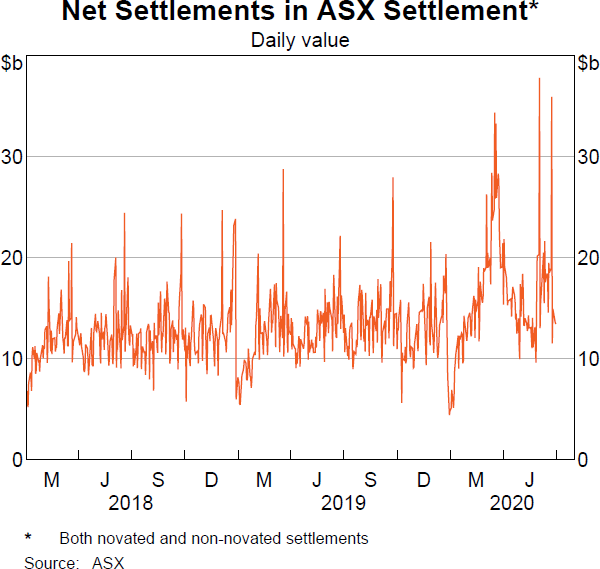
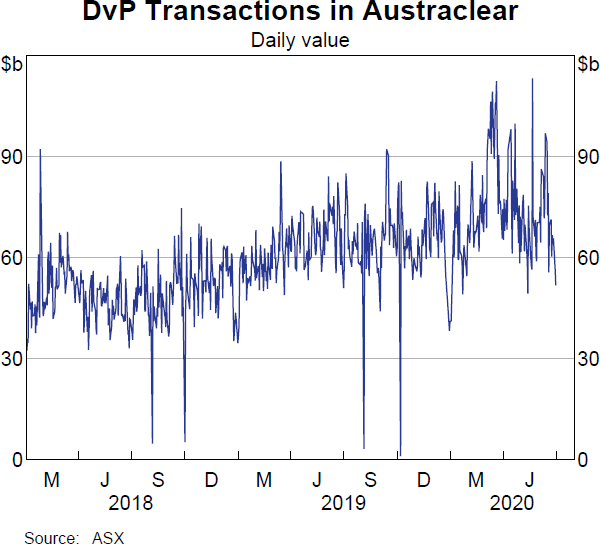
Central counterparties
CCPs play a major role in managing the risks associated with trading in financial instruments. CCPs stand between the counterparties to a financial trade, acting as the buyer to every seller and the seller to every buyer; this activity is known as clearing. Participants in cleared markets have credit and liquidity exposures only to the CCP, rather than other participants in the market.
In the absence of a participant default, the CCP is not exposed to market risk as it stands between counterparties with opposite (i.e. offsetting) positions. However, in the event that a participant defaults, the CCP must continue to meet its obligations to its surviving participants. In such an event, the CCP faces potential losses from changes in the value of a defaulting participant's portfolio until it closes out the positions in that portfolio.
To mitigate the risk of such losses, CCPs maintain prefunded resources, typically in the form of initial margin and default funds. Initial margin is collected from participants and is sized to cover potential future losses, to a specified confidence interval, on a participant's portfolio in the event they default. Accordingly, aggregate initial margin provides a risk-based measure of the magnitude of exposures faced by CCPs. Default funds comprise contributions from participants and/or the CCP itself and are available to cover losses if, in the event of default, the defaulting participant's margin is exhausted.[9]
Four CCPs are licensed to provide services in Australia:
- ASX Clear Pty Limited (ASX Clear) provides CCP services for ASX-quoted cash equities, debt products and warrants traded on the ASX and Chi-X markets and equity-related derivatives traded on the ASX market or over-the-counter (OTC).
- ASX Clear (Futures) Pty Limited (ASX Clear (Futures)) provides CCP services for futures and options on interest rate, equity, energy and commodity products traded on the ASX 24 market, as well as AUD and New Zealand Dollar (NZD)-denominated OTC interest rate derivatives (IRD).
- LCH Limited's (LCH Ltd) SwapClear service provides CCP services for OTC IRD and inflation rate derivatives.
- Chicago Mercantile Exchange Inc. (CME) provides CCP services for OTC IRD, and non-AUD IRD traded on the CME market or the Chicago Board of Trade market for which CME permits portfolio margining with OTC IRD. CME is also licensed to provide clearing services for commodity, energy and environmental derivatives traded on the financial market to be operated by FEX Global Pty Ltd (FEX).
Activity
The ASX CCPs clear cash equities as well as exchange-traded futures and options. Trading activity in both equity derivatives – equity exchange-traded options (ETOs) and ASX SPI200 – and cash equities spiked in the first half of 2020 (Graph 22). The average daily value of trading activity in equities in the March quarter was nearly 35 per cent above the 2019 daily average; the number of trades was also elevated, with the highest volume day in cash equities more than double the pre-February peak. These unprecedented volumes caused some processing delays at ASX Clear. The surge in activity was associated with significant volatility in the equities markets in the March quarter, before stabilising in the June quarter (Graph 23).
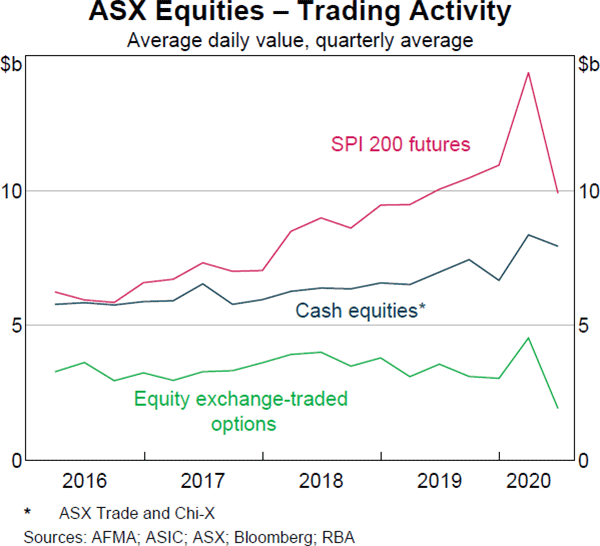
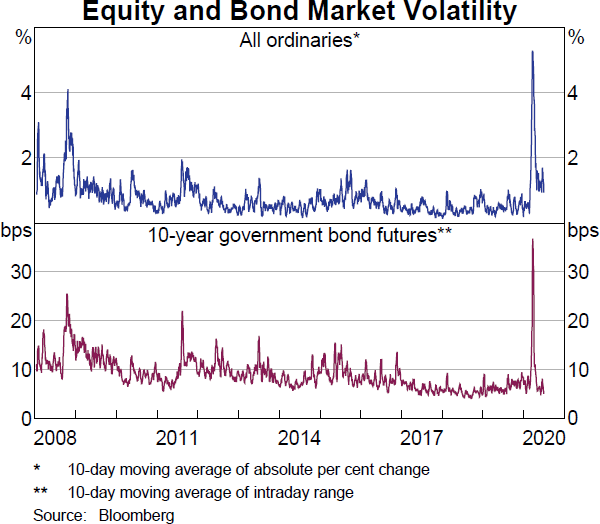
After picking up at the start of 2020, trading activity in all three interest rate futures contracts contracted in the June quarter (Graph 24). This was most pronounced in 90-day bank bill futures, for which trading activity was 70 per cent below June 2019 levels. The initial increase in activity in the first quarter of 2020 was associated with periods of significant volatility in interest rates particularly in mid March (Graph 23). The announcement of policy responses, including the Bank's initiative to purchase government bonds across the yield curve, with a target for the three-year yield, helped stabilise yields and reduced uncertainty about the future path of interest rates. As volatility and uncertainty declined, trading activity also fell, particularly in the shorter-term contracts.
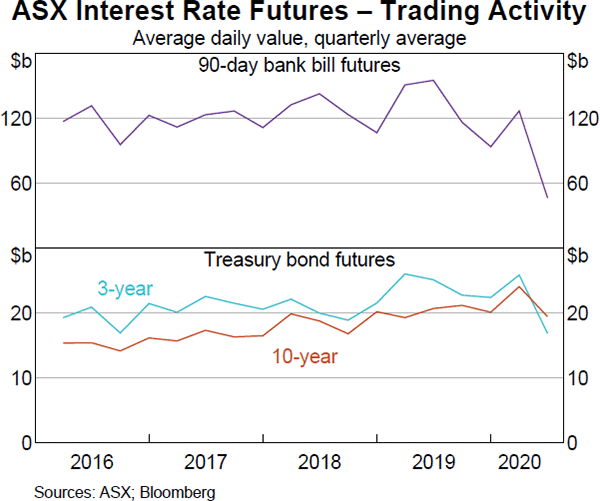
In OTC markets, ASX Clear (Futures), CME and LCH Ltd all offer central clearing for AUD-denominated IRD. As at June 2020, 85 per cent of centrally cleared AUD OTC IRD outstanding were cleared at LCH Ltd, with most of the remaining share cleared at ASX Clear (Futures) (Graph 25). These market shares have been broadly steady in recent years. ASX Clear (Futures) has eight participants in its OTC service and SwapClear has six Australian-incorporated entities participating directly, while CME has no Australian direct participants. A number of Australian-based banks, superannuation funds and other institutional investors clear products at all three CCPs indirectly as clients of other direct participants.
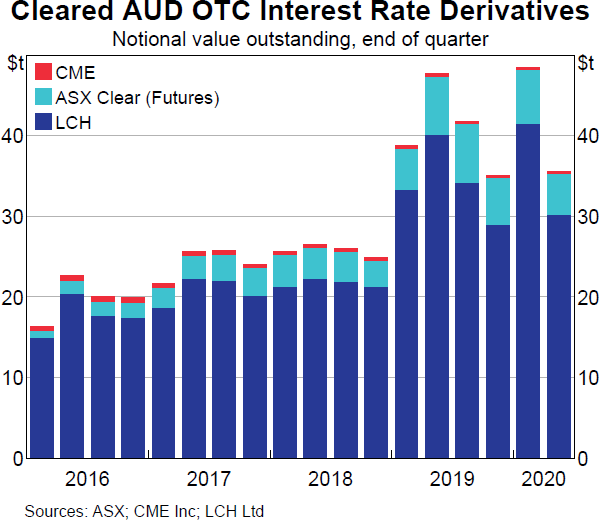
The notional value of all centrally cleared AUD-denominated OTC IRD declined in the second half of 2019 before picking up in early 2020. This was driven by activity in overnight index swaps (OIS) (short-term interest rate swaps tied to the cash rate) reflecting changing expectations about the likely path of the cash rate as news of the COVID-19 pandemic emerged (Graph 26). Activity in OIS is typically more volatile than other interest rate swaps, although they contribute less risk because they are relatively short-term in duration. Interest rate swaps and OIS account for the majority of outstanding AUD-denominated OTC IRD positions, though basis swaps, zero-coupon swaps and variable notional swaps are also cleared.
Globally, the notional value of OTC IRD trades outstanding in all currencies also increased in early 2020 (Graph 27). Interest rate swaps make up the largest share of exposures, though the COVID-related pick-up was primarily driven by shorter-dated OIS and forward rate agreements (FRA). AUD-denominated contracts make up a small share of outstanding contracts in all currencies – around 6 per cent at LCH Ltd's SwapClear service and less than 1 per cent at CME as at the end of June.
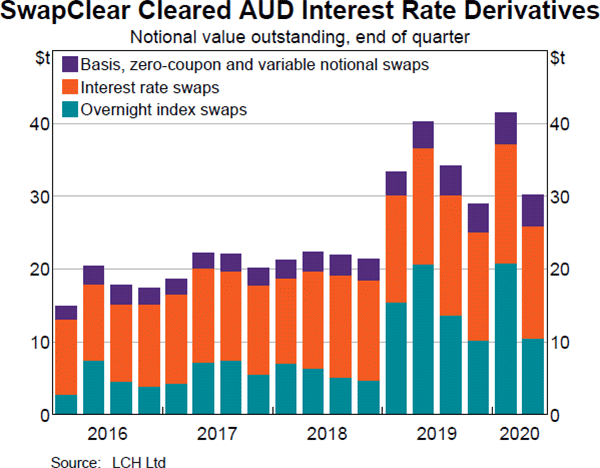
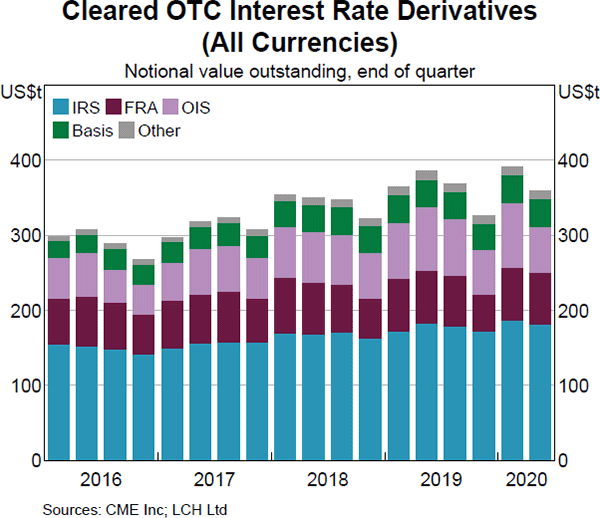
Margin
Interest rate futures and the ASX SPI200 futures comprise the majority of exposures at ASX Clear (Futures), as measured by initial margin. The total amount of margin held by ASX Clear (Futures) spiked in March 2020, reaching a peak of $9 billion, higher than the previous peak of $8 billion in December 2019 (Graph 28). This increase largely reflected increases in margin rates for both equity futures and OTC interest rate derivatives.
ASX Clear manages exposures from its participants' trades in cash equities and equity ETOs (other than on the ASX SPI200 futures). Margin at ASX Clear increased substantially in early 2020, as ASX increased the margin rates charged on both cash equities and equity derivatives (Graph 29). Margin held against cash equities is generally much lower than for equity derivatives because of the short (two day) duration of cash equity trades.
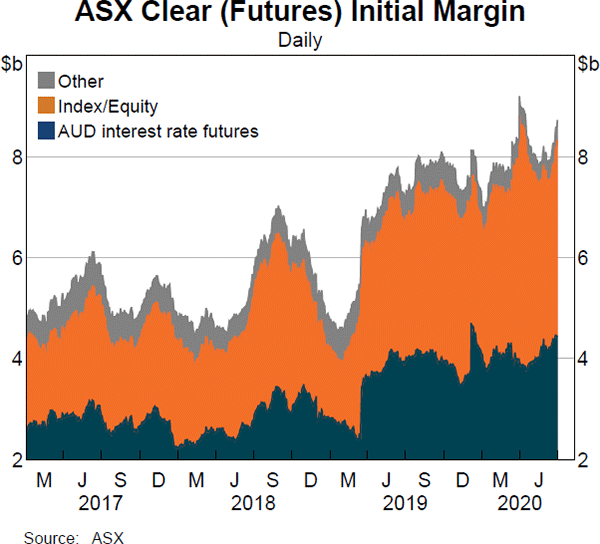
Globally, margin requirements at both LCH Ltd and CME also increased over this period reflecting similar factors to those seen in domestic markets (Graph 30).
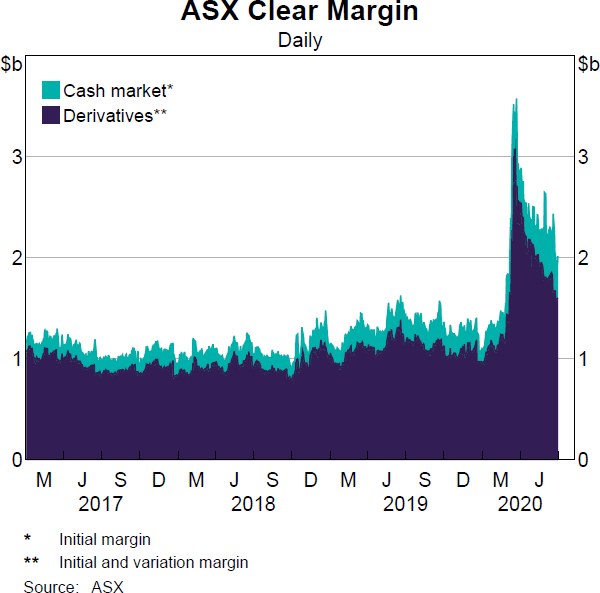
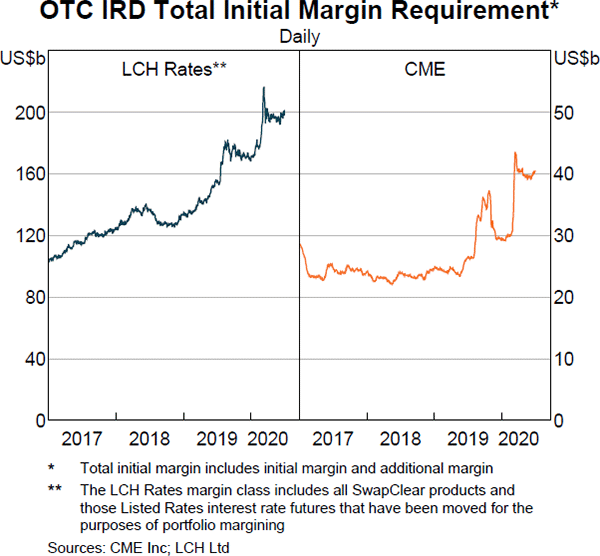
Variation margin flows, which prevent the build-up of current exposures as prices move, increased substantially in March for ASX Clear (Futures), CME and LCH Ltd, but have since fallen significantly (Graph 31; Graph 32). The increase in margin flows reflected the elevated volatility in markets, with variation margin directly linked to realised volatility as it reflects the market revaluation of participants' positions.
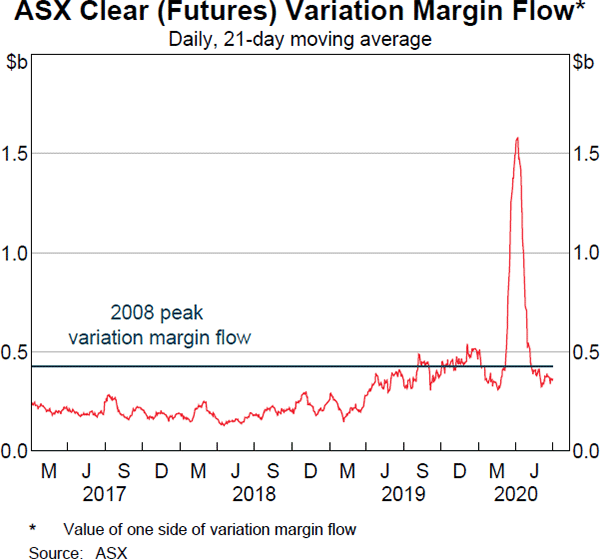
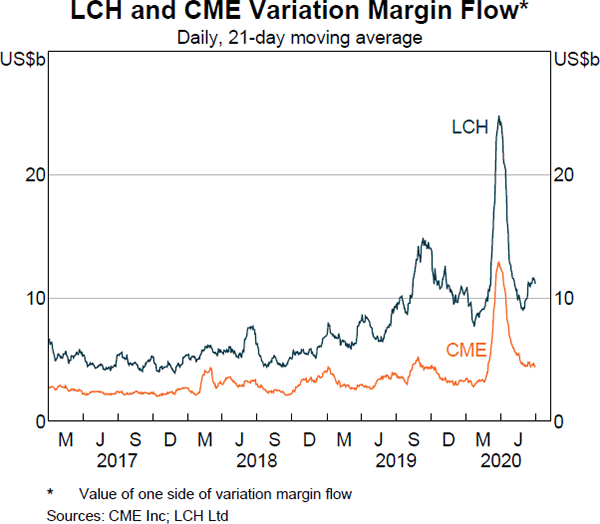
Uncleared margin rules
Consistent with the G20's OTC derivatives reforms that introduced mandatory central clearing of OTC IRD trades between internationally active dealers, Australian banks centrally clear over 80 per cent of their OTC IRD transactions.
Firms that are not subject to mandatory clearing requirements have also been taking up clearing as a result of changing incentives. These incentives include factors such as increased liquidity and netting benefits for centrally cleared derivatives, as well as changing regulations such as higher capital and margin requirements for OTC derivatives that are not cleared. The uncleared margin rules require counterparties to post initial margin for non-centrally cleared OTC derivatives trades and have been implemented progressively. In light of the operational and financial challenges posed by COVID-19, global and domestic regulators have extended the deadlines for the final two implementation phases by one year.[10],[11] By imposing higher costs for OTC derivatives trades that are not centrally cleared, it is expected that a number of firms captured by the final phases will begin or continue to shift towards clearing.
Benchmark reform
In line with the Financial Stability Board's (FSB's) recommendations to improve the robustness of interest rate benchmarks, CCPs are expanding the list of products eligible for clearing to include swaps that reference new risk-free rates (RFRs). LCH Ltd's SwapClear service and CME's IRS service offer clearing of USD swaps referencing the secured overnight financing rate (SOFR); LCH Ltd also clears euro (EUR) swaps referencing the euro short-term rate (€STR).[12] Clearing of these products is expected to further increase as the industry converts the interest rates used to discount cash flows on contracts settled in these currencies from the interbank offered rate (IBOR) to the new risk-free rate. The discount rate for EUR swaps was converted to €STR in July 2020; the switch to SOFR discounting for USD swaps is scheduled for mid October 2020. This will not be required for AUD swaps; these are already discounted using the risk-free rate rather than the IBOR benchmark, which will continue to be published.[13]
Footnotes
For a comparison of international money transfer prices offered by the major banks and new digital providers, see Graph 6 in Lowe (2019), ‘A Payments System for the Digital Economy’, speech to the 2019 Australian Payments Network Summit, 10 December. Available at <https://www.rba.gov.au/speeches/2019/sp-gov-2019-12-10.html>. [7]
See Australian Payments Network (2020), ‘Australian Payment Fraud 2020’, August. Available at <https://www.auspaynet.com.au/resources/fraud-statistics/2019-Calendar-year>. [8]
CCPs also call variation margin to cover the exposure to actual changes in market prices to prevent the build-up of current exposures. It is collected from participants with mark-to-market losses, and typically paid out to participants with gains. [9]
Basel Committee and IOSCO (2020), ‘Basel Committee and IOSCO announce deferral of final implementation phases of the margin requirements for noncentrally cleared derivatives’, Press Release, 3 April. Available at <https://www.iosco.org/news/pdf/IOSCONEWS560.pdf>. [10]
APRA (Australian Prudential Regulatory Authority (2020), ‘APRA announces new commencement dates for prudential and reporting standards’, 16 April. Available at <https://www.apra.gov.au/news-and-publications/apra-announces-new-commencement-dates-for-prudential-and-reporting-standards>. [11]
ASX Clear (Futures) does not offer clearing of USD or EUR swaps and so has not introduced new RFR products. [12]
Alim and Connolly (2018), ‘Interest rate benchmarks for the Australian dollar’, RBA Bulletin, September, viewed 10 September 2020. Available at <https://www.rba.gov.au/publications/bulletin/2018/sep/interest-rate-benchmarks-for-the-australian-dollar.html>. [13]